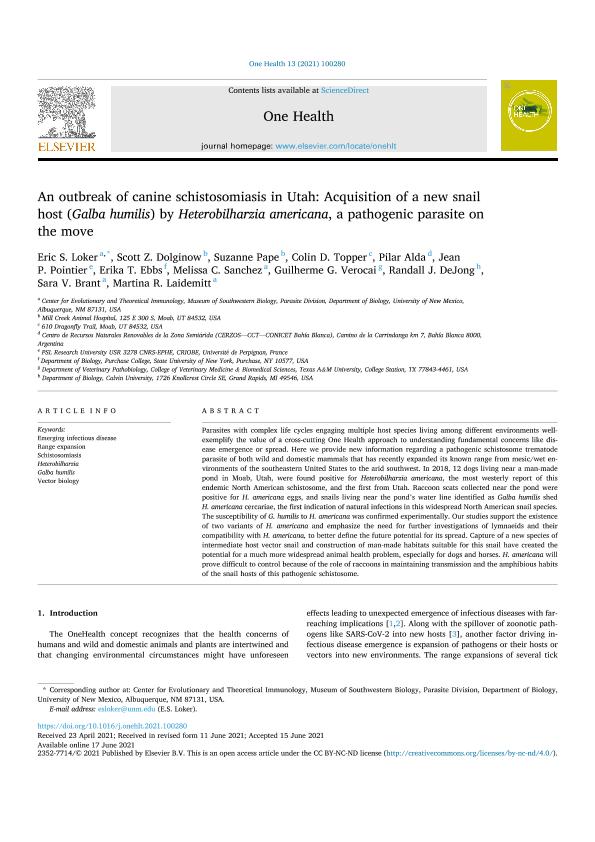Mostrar el registro sencillo del ítem
dc.contributor.author
Loker, Eric S.
dc.contributor.author
Dolginow, Scott Z.
dc.contributor.author
Pape, Suzanne
dc.contributor.author
Topper, Colin D.
dc.contributor.author
Alda, Maria del Pilar

dc.contributor.author
Pointier, Jean Pierre

dc.contributor.author
Ebbs, Erika T.
dc.contributor.author
Sanchez Herrera, Melissa

dc.contributor.author
Verocai, Guilherme G.
dc.contributor.author
DeJong, Randall J.
dc.contributor.author
Brant, Sara V.
dc.contributor.author
Laidemitt, Martina R.
dc.date.available
2022-01-25T18:49:58Z
dc.date.issued
2021-12
dc.identifier.citation
Loker, Eric S.; Dolginow, Scott Z.; Pape, Suzanne; Topper, Colin D.; Alda, Maria del Pilar; et al.; An outbreak of canine schistosomiasis in Utah: Acquisition of a new snail host (Galba humilis) by Heterobilharzia americana, a pathogenic parasite on the move; Elsevier B.V.; One Health; 13; 12-2021; 1-10; 100280
dc.identifier.issn
2352-7714
dc.identifier.uri
http://hdl.handle.net/11336/150647
dc.description.abstract
Parasites with complex life cycles engaging multiple host species living among different environments well-exemplify the value of a cross-cutting One Health approach to understanding fundamental concerns like disease emergence or spread. Here we provide new information regarding a pathogenic schistosome trematode parasite of both wild and domestic mammals that has recently expanded its known range from mesic/wet environments of the southeastern United States to the arid southwest. In 2018, 12 dogs living near a man-made pond in Moab, Utah, were found positive for Heterobilharzia americana, the most westerly report of this endemic North American schistosome, and the first from Utah. Raccoon scats collected near the pond were positive for H. americana eggs, and snails living near the pond´s water line identified as Galba humilis shed H. americana cercariae, the first indication of natural infections in this widespread North American snail species. The susceptibility of G. humilis to H. americana was confirmed experimentally. Our studies support the existence of two variants of H. americana and emphasize the need for further investigations of lymnaeids and their compatibility with H. americana, to better define the future potential for its spread. Capture of a new species of intermediate host vector snail and construction of man-made habitats suitable for this snail have created the potential for a much more widespread animal health problem, especially for dogs and horses. H. americana will prove difficult to control because of the role of raccoons in maintaining transmission and the amphibious habits of the snail hosts of this pathogenic schistosome.
dc.format
application/pdf
dc.language.iso
eng
dc.publisher
Elsevier B.V.

dc.rights
info:eu-repo/semantics/openAccess
dc.rights.uri
https://creativecommons.org/licenses/by/2.5/ar/
dc.subject
EMERGING INFECTIOUS DISEASE
dc.subject
GALBA HUMILIS
dc.subject
HETEROBILHARZIA
dc.subject
RANGE EXPANSION
dc.subject
SCHISTOSOMIASIS
dc.subject
VECTOR BIOLOGY
dc.subject.classification
Otras Ciencias Biológicas

dc.subject.classification
Ciencias Biológicas

dc.subject.classification
CIENCIAS NATURALES Y EXACTAS

dc.title
An outbreak of canine schistosomiasis in Utah: Acquisition of a new snail host (Galba humilis) by Heterobilharzia americana, a pathogenic parasite on the move
dc.type
info:eu-repo/semantics/article
dc.type
info:ar-repo/semantics/artículo
dc.type
info:eu-repo/semantics/publishedVersion
dc.date.updated
2021-12-03T19:24:44Z
dc.journal.volume
13
dc.journal.pagination
1-10; 100280
dc.journal.pais
Países Bajos

dc.journal.ciudad
Amsterdam
dc.description.fil
Fil: Loker, Eric S.. University of New Mexico; Estados Unidos
dc.description.fil
Fil: Dolginow, Scott Z.. Mill Creek Animal Hospital; Estados Unidos
dc.description.fil
Fil: Pape, Suzanne. Mill Creek Animal Hospital; Estados Unidos
dc.description.fil
Fil: Topper, Colin D.. No especifíca;
dc.description.fil
Fil: Alda, Maria del Pilar. Consejo Nacional de Investigaciones Científicas y Técnicas. Centro Científico Tecnológico Conicet - Bahía Blanca. Centro de Recursos Naturales Renovables de la Zona Semiárida. Universidad Nacional del Sur. Centro de Recursos Naturales Renovables de la Zona Semiárida; Argentina
dc.description.fil
Fil: Pointier, Jean Pierre. Centre National de la Recherche Scientifique; Francia
dc.description.fil
Fil: Ebbs, Erika T.. State University of New York; Estados Unidos
dc.description.fil
Fil: Sanchez Herrera, Melissa. University of New Mexico; Estados Unidos
dc.description.fil
Fil: Verocai, Guilherme G.. Texas A&M University; Estados Unidos
dc.description.fil
Fil: DeJong, Randall J.. Calvin University; Estados Unidos
dc.description.fil
Fil: Brant, Sara V.. University of New Mexico; Estados Unidos
dc.description.fil
Fil: Laidemitt, Martina R.. University of New Mexico; Estados Unidos
dc.journal.title
One Health
dc.relation.alternativeid
info:eu-repo/semantics/altIdentifier/doi/http://dx.doi.org/10.1016/j.onehlt.2021.100280
dc.relation.alternativeid
info:eu-repo/semantics/altIdentifier/url/https://www.sciencedirect.com/science/article/pii/S2352771421000707
Archivos asociados
